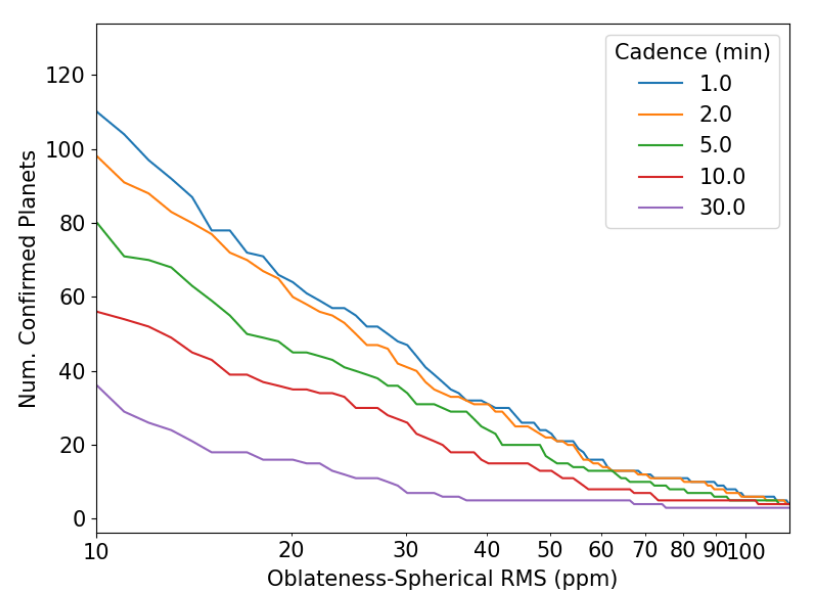Title: On The Effects of Planetary Oblateness on Exoplanet Studies
Authors: David Berardo and Julien de Wit
First Author’s Institution: MIT Kavli Institute for Astrophysics and Space Research, 77 Massachusetts Avenue, Building 37, Cambridge, MA 02139
Status: Accepted to the Astrophysical Journal, available on arXiv
The world is a complicated place, and all scientists are just storytellers trying their best to explain it with more and more accurate fables. One of their most commonly accepted tropes in the canon of physics is assuming that anything round-ish, even cows, are perfect spheres. Astronomers implicitly do this all the time when it comes to exoplanets: we assume that all of them, big and small, hot and cold, are all immaculate orbs.
Even in our own solar system though, we know that this is not strictly true. Consider the hypothetical cosmic prospector: If they wanted to drill a hole to the center of Saturn, they’d better carefully consider their starting location. If they broke “ground” on the equator, they’d have to dig about 10% further than if they had started from the North Pole (setting aside the difficulties of “digging” through a gas giant). This is because Saturn is slightly squashed: its equatorial radius is larger than its polar radius, and it bulges out in the middle due to its rapid rotation.
Even though our investigations of worlds beyond our neighborhood have turned up strange and unexpected systems wholly different from our own, we have no reason to assume that there wouldn’t be similarly squished planets out there. Today’s authors take that tension between our simple models and expectation of non-spherical planets and answer two resulting questions: can we do better and actually measure a planet’s bulge, and if not, what are the implications of using the wrong model?
Can we detect it?
Actually measuring the degree of squishiness, more technically called oblateness, of a planet is tricky work. When we observe the transit of an exoplanet, the only thing we can measure at any moment is the area of the star blocked by the planet, not the shape of the photobomber blocking the light. As Figure 1 shows, the only time an oblate planet gives itself away are the moments it enters and exits our stage, just as it’s crossing the stellar limbs. Only then is the area blocked by the star different than we’d expect for a spherical interloper.

To assign a quantitative measure of this difference, the authors created fake data of oblate and spherical planets passing in front of their stars, zoomed in on just the beginning and end of the transits, then measured the RMS of the difference between the two types of planets. They found that this value depends strongly on the cadence, or amount of time between measurements, of their fake data: this is illustrated in Figure 2. All told, they estimate that several 10s of currently known planets would differ from a spherical model by a few 10s of parts per million if they were actually oblate.

Unfortunately, most of our transit measurements aren’t that precise, meaning it would be very difficult to measure the oblateness of a single planet using existing data. That said, even though it isn’t easy to measure the oblateness of one planet, Kepler data is good enough to make statements about population-level trends. After fitting some real Kepler data with their oblate model, the authors conclude that most planets aren’t severely oblate, and that short-period planets don’t seem to be systematically more oblate than long-period planets.
How wrong is circular?
If we can’t really measure the oblateness of a moderately squished planet, it’s natural to wonder: does that matter?
Unfortunately, the authors show that yes, it might. Much like a slightly square peg can still be jammed through a round hole, we can still fit an oblate light curve with a circular model, but it won’t be a great match. Our estimates for many of the model parameters will be biased- that is, they’ll lean away from their true value in a given direction. For example, in Section 3 of the paper, the authors show that we’re likely to underestimate the true radius of a planet and overestimate its inclination.
This is unfortunate, but truly important when we consider the downstream effects of how we use these transit-derived parameters to construct other descriptions of a planet. For a growing number of planets, astronomers have measured their radius via the transit technique and its mass via careful monitoring of the host star’s radial velocity. It is tempting to combine these measurements into the estimate of the density of the planet: but, doing so requires assuming the volume of the planet, which requires assuming the planet is spherical, or at least that your measured radius is correct. If either of those are false, your final density will be incorrect. The authors estimate that available data can only rule out oblateness over about 0.25, but that if a planet was even slightly rounder than that, we’d get its density wrong by over 10%.
It’s nice to pretend that all cows are spheres. But, we learn a lot, and can be more honest about the accuracy of our measurements, when we consider that some planets might be more complicated than we’d wish.
Astrobite edited by Lili Alderson
Featured image credit: James O’Donoghue, @physicsJ on Twitter




